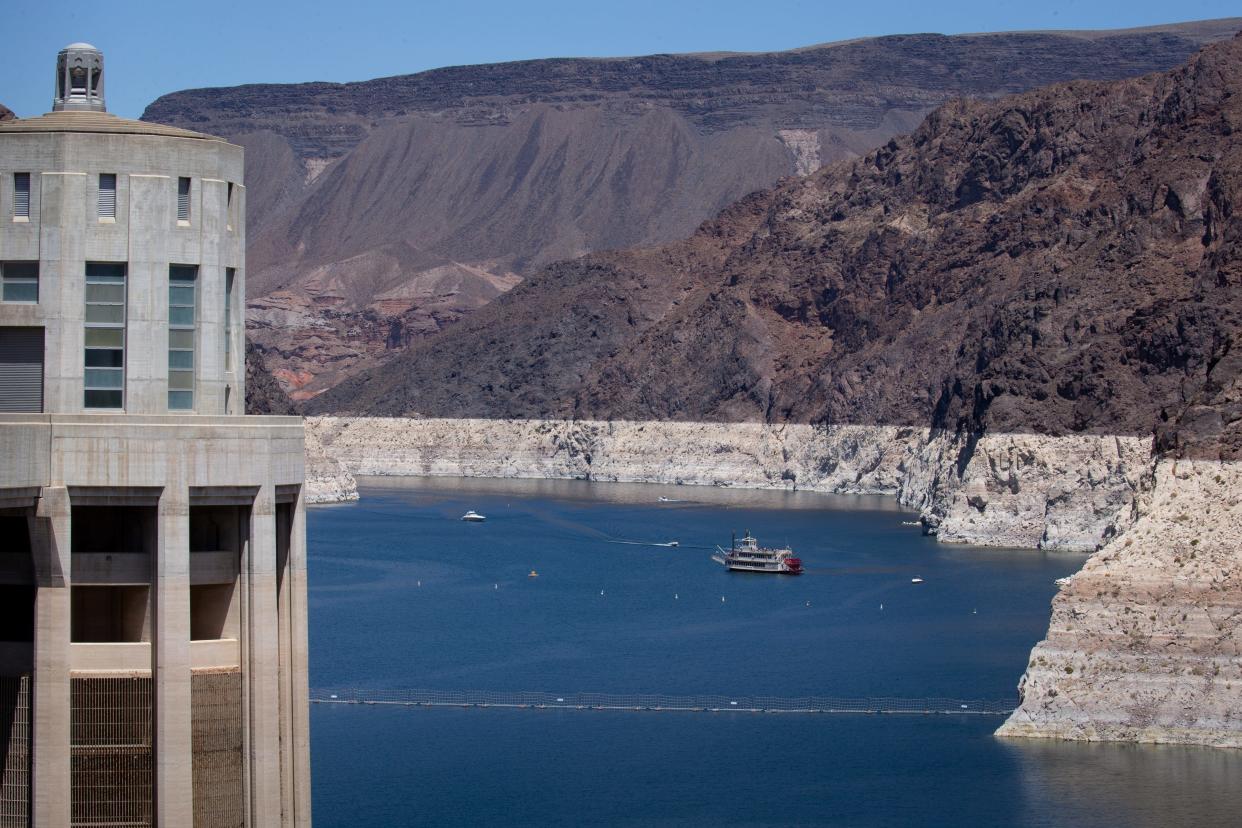Feds finalizing $250M in water-saving measures to help drought-stricken Lake Mead

The U.S. Bureau of Reclamation is finalizing $250 million in water-saving deals that are expected to preserve up to 10 feet of Lake Mead's declining surface levels this year, agency Commissioner Camille Calimlim Touton announced Friday in Tempe.
The commissioner attended a discussion of Colorado River water issues at Arizona State University, organized by Sen. Mark Kelly, D-Arizona. The money will pay Lower Colorado River Basin water users, especially farmers, to forego some of their deliveries this year to help keep the reservoir from sinking further toward the point where it no longer flows past Hoover Dam.
The initial funding is essentially an emergency measure that pays people not to use water temporarily. Reclamation ultimately will apply other funds approved by Congress over the last two years to projects that increase on-farm efficiency, Touton said, such as canal liners and drip irrigation systems.
“It allows for agricultural communities to thrive,” she said.
The $250 million announced Friday is part of a $4 billion drought-relief fund that Kelly helped secure in last year’s Inflation Reduction Act. The first set of agreements is intended as a short-term fix to arrest the reservoir’s immediate decline, he said. Much more is needed for future years.
“We need long-term conservation,” he said.
Sen. Kyrsten Sinema, I-Arizona, also has claimed credit for securing the funds, and recently held her own roundtable in Phoenix where she assured central Arizona municipal leaders that she would help them navigate the funding process to make investments in urban water conservation and reuse.
Arizona Water Resources Director Tom Buschatzke said the money, when combined with locally generated funds such as the $200 million the Arizona Legislature committed to conservation last year, should ease the way for an interstate deal to prevent the Colorado River’s collapse without resorting to state-vs.-state litigation. He said he’s optimistic in part because the seven states that share the river with Mexico are having “better conversations” than they had before submitting competing plans in January for allocating cuts in water use.
Buschatzke expects to meet again with his counterparts from other states later this month.
Colorado River: How a 'cold shock' of water from Lake Powell could thwart invasive Grand Canyon bass
The federal government is due to reveal its own suggested alternative this spring before deciding on a plan for maintaining reservoir levels until dam-management rules are set for a rewrite in 2026. Touton could not say when her agency will share its ideas, but she told The Arizona Republic it would happen before June.
The Gila River Indian Community has previously said it would leave up to 125,000 acre-feet of its water in Lake Mead during each of the next three years if it receives funding. Gila River Indian Community Gov. Stephen Roe Lewis reiterated that commitment on Friday, and said his government was closing in on a deal with Reclamation. That water will help alleviate the immediate crisis on the river, especially in a year when officials are expecting above-average snowmelt to flow downstream. But it does not approach the 2 million to 4 million acre-feet that Reclamation says the region must save every year in the future to prevent calamity.
For comparison, Arizona’s full share of the river is 2.8 million acre-feet. California’s is 4.4 million.
In all, Touton and Kelly said, the $250 million commitment is expected to keep 650,000 acre-feet in Lake Mead this year. They did not immediately announce specific deals beyond the Gila River Indian Community’s, though Elston Grubaugh, the leader of the Yuma area’s Wellton-Mohawk Irrigation and Drainage District, said his district was negotiating a deal with Reclamation. Wellton-Mohawk farmers prefer efficiency upgrades to crop fallowing, he said, but may agree to leave some fields unplanted seasonally on a temporary basis.
Leaders from both the Central Arizona Project and Salt River Project told Kelly and Touton that federal funds in later years could significantly shore up the state's infrastructure to hold more water. CAP suggested a reservoir near the lower river to capture stormwater that sometimes flows to Mexico in volumes beyond the U.S. treaty obligation, while SRP advanced its plan to raise Bartlett Dam to hold back more Verde River water in wet winters such as this one.
Brandon Loomis covers environmental and climate issues for The Arizona Republic and azcentral.com. Reach him at brandon.loomis@arizonarepublic.com or follow on Twitter @brandonloomis.
Environmental coverage on azcentral.com and in The Arizona Republic is supported by a grant from the Nina Mason Pulliam Charitable Trust. Follow The Republic environmental reporting team at environment.azcentral.com and @azcenvironment on Facebook, Twitter and Instagram.
You can support environmental journalism in Arizona by subscribing to azcentral.com today.
This article originally appeared on Arizona Republic: Colorado River water-saving deals worth $250M planned by Reclamation

